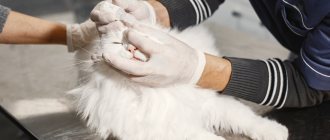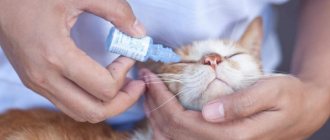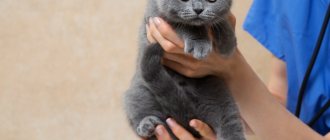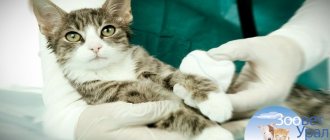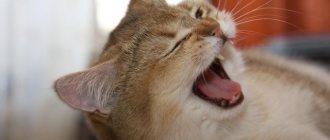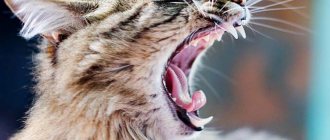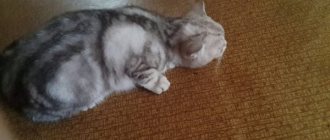13242Administration
1
Many owners often wonder why their cat sneezes and his eyes water. Some consult with a veterinarian, others try to overcome it on their own by washing the eyeball with herbal or tea infusions, while others hope that it will go away on its own.
Often the owner still pays attention to the fact that the animal is sneezing. If it sneezes due to dust particles getting into the nasal passage, then there is no need to worry. But when a runny nose and sneezing become permanent, it is necessary to figure out why the animal is sneezing and eliminate the disease.
Tears in animals perform a protective function, which is similar to the processes occurring in humans. Tears appear if dust or speck gets in. This is normal. But if the cat behaves restlessly and the flow of tears continues for a sufficient time, then this process must be stopped.
© shutterstock
If a cat’s eyes are watery and sneezing at the same time, then these are good reasons to seek help from a doctor.
Causes
What should you do if your cat sneezes and his eyes water?
Watery eyes and sneezing can occur either from ordinary litter or from a serious infection. Therefore, at the first symptoms, it is recommended to see a specialist.
The most common reasons why a cat's eyes are watery are:
Allergy . This phenomenon is quite common. Allergic reactions can be caused by various household products, perfumes, deodorants, pollen, mold, and even cat litter.
It often happens that a baby sneezes on his own fur , which ends up in various organs. Irritation and fluid discharge from the eyes can be caused by blood-sucking insects: mosquitoes and fleas.
In case of allergies, you need to find sources and methods to eliminate them.
- Conjunctivitis . Many bacteria and infections can cause inflammation of the organ mucosa. Conjunctivitis is accompanied by itching, the eyelids become swollen, and pus may drain from the eyes. With complex manifestations of this disease, fever may appear. The cat will be weak. There may also be a lack of appetite.
- Children's age of a cat . Strong production of tears is typical for newborn kittens who have opened their eyes for the first time. Usually the mother cat does the washing. But if she is not nearby, then the kitten’s eyes should be wiped with boiled water or an infusion of weak tea.
- Breed personality . There are special breeds of cats, such as Persians, Britons and Sphynxes, in which lacrimation occurs due to their anatomical shape of the eyes and structure of the skull. Such animals require careful care.
- Weakened immunity . Such cats are more often exposed to diseases and infections. Often with the following symptoms: sneezing, coughing, watery eyes. To strengthen the immune system and to never hear the animal sneeze, you should get special vaccinations and monitor the cat’s diet.
- Infectious diseases . The eyes are watery, the pet is sneezing - all this can occur with the following infections: chlamydia, calcivirosis, rhinotracheitis and others. Some of them are transmitted by airborne droplets, so the owner is at risk of becoming infected. To prevent various infections, as well as to avoid identifying the reasons why your friend is sneezing and his visual organs are watery, it is recommended to vaccinate the animal on time.
- Eye diseases . Of these, glaucoma and cataracts are well known. These are very serious illnesses that appear due to improper metabolism and can lead to loss of vision in a cat. In the early stages, the disease is quite easy to recognize. At a later stage, the cat’s vision decreases, the lens becomes cloudy, and lacrimation appears.
- Helminths . When cats develop worms, vomiting, diarrhea, lack of appetite, and excessive lacrimation are possible.
- Eye damage . If a cat has an injury in the area of these organs and they are tearing a lot, then it is necessary to inspect this area. If the wound is not severe, then simply treating it with Furacilin solution will help. For severe bruises, you should consult a doctor.
How to diagnose the disease yourself?
As a rule, any organism strives for self-healing; this is inherent in the nature of any creature, including cats.
Therefore, symptoms in the form of a runny nose are quite normal, they are simply freed from dust particles, foreign bodies and other nasties. With the help of observations and simple actions, we can independently understand the nature of the disease that has overtaken our pet. A cat's refusal to eat and constant attempts to rub its nose indicate a runny nose and a cold. In this case, everything will work out if you take action in time.
Identifying an eye infection is also quite easy. Its symptoms are an increased sneeze reflex and watery eyes. There may be reasons for this. It's not difficult to figure them out. The main thing is not to consider this as the norm. This is a more serious disease, and accordingly the treatment method will be different.
Our curious little pets have the ability to climb into any jar, smell, taste, lick. Unfortunately, this can lead to more severe allergies. Be vigilant and try to remove all dangerous materials. If everything has already happened, find this remedy and act according to the situation.
Foreign objects that get into the nasopharynx will not give rest to the cat. He will do his best to try to get rid of it through snorting and intensive nose scratching.
But combined with bad breath, swollen gums and purulent processes, this is a rather unpleasant signal and a visit to the dentist will be very necessary. Long-haired cats may have watery eyes from their own fur.
As a rule, discharge comes in different colors and indicates different symptoms, causes and diseases. Green or gray snot when sneezing indicates the presence of a fungus or infection in the body. Colorless discharge combined with watery eyes indicates the presence of an allergy.
It is not always possible to identify diseases such as asthma on your own. But if this is so, then irritants and all unpleasant odors must be eliminated from the home or pet’s habitat.
When is help needed?
If your animal has the following symptoms, then a trip to the veterinarian is required:
- the cat is constantly sneezing;
- his eyes are watering;
- no appetite;
- irritation and itching in the area of the visual organ;
- purulent discharge;
- the eyes became a different color and became cloudy;
- the animal is very lethargic or, on the contrary, overexcited;
- There are deep wounds and cuts.
The doctor will conduct an examination and prescribe the right treatment, thanks to which you will not hear or see your baby sneezing or his eyeballs watering.
Discharge from the eyes.
Transparent or brownish tears, occasionally and a little - this is natural.
By the way, brown liquid happens due to mixing feed from different manufacturers or artificial with natural ones. Adjust your diet and wash your pet's eyes with chamomile decoction.
But excessive tearfulness (and redness of the eyes) indicates that the outflow of tears is impaired, foreign objects have entered, or a disease has begun.
Suppuration of the eyeball, swelling and redness of the eyelids, the animal squints, cannot open its eyes - is associated either with a serious infection (conjunctivitis, for example), or due to a foreign body located there, or damage during a fight. On the same day - consultation and treatment, and in case of self-medication, you will miss precious time.
With the help of drugs
When an animal sneezes and its pupils are watery, the doctor suggests treatment with the following means:
- Anandin. This medicine helps in rapid healing of wounds and has antimicrobial effects;
- Maxidin. Has good immunostimulating properties. May help with inflammation of the eyes and rhinitis;
- Thymogen. This is a drug that regulates the immune system.
If no positive trends are observed, then, on the recommendation of a doctor and under his supervision, the following pills should be taken:
- Naphthyzin. It comes in the form of nasal or eye drops. Has the property of constricting blood vessels and has an antiphlogistic effect;
- Dioxidine. It is used for purulent rhinitis and has disinfectant properties;
- Derinat. Helps strengthen the immune system, used mainly for rhinitis and conjunctivitis;
- Nazivin. It comes in the form of drops: both for the nose and for the eyes. Used to reduce inflammation in these areas.
© shutterstock
If the cat has a serious illness, then the following medications are prescribed:
- Drops "Diamond eyes". They have an antimicrobial and regenerating effect thanks to components such as chlorhexidine, sodium succinate and taurine;
- Furacilin. It is contained in the drug "Bars", which fights microbes well. Novocaine, which is part of it, anesthetizes. Prescribed for severe keratitis;
- “Iris” is the name given to the drops that are used to treat a corneal ulcer. The composition contains the antibiotic gentamicin and many healing elements;
- To treat inflammation of the conjunctiva, Ciprovet is used, which contains the antibiotic ciprofloxacin.
Treatment of sneezing
So, if your baby or cat has a runny nose and starts sneezing, drops prescribed by the doctor will come to your aid. They will fight all bacteria, and soon your cat will regain peace of mind and health. Just drip into food until symptoms disappear .
In most cases, foreign objects can be removed from the nose on your own. But if you are not confident in your own abilities, hand the animal over to specialists, they will do everything right. If the foreign body is a nasal tumor, immediately hospitalize your pet; he needs surgery.
If a dental examination gives disappointing results in the form of problems with teeth, gums or inflammation, then you know which doctor can help in this case. After all procedures, symptoms should stop.
Allergy to mold is treated by eliminating this very mold and various ointments for external use. Remember, excluding the external irritant from the cat’s environment will reduce the allergy to nothing. If it's all about infection, then drugs based on natural plants .
Remember, care, care and compliance, following all doctor’s orders and observing basic hygiene rules can work wonders. Wash your hands after and before handling the cat, and dry your eyes with a clean towel. If your condition worsens, contact the clinic for help.
How to carry out the procedure?
It is very important to hold the cat well with a towel during any medical procedure. Because any sudden movement of the pet can cause even more harm to it.
How to do it? First you need to prepare the place for burial. It is wiped with a cotton pad previously moistened with the necessary solution. Dried purulent discharge softens and is easily removed.
The next step is to take the following steps:
- prepare medications;
- pull back the eyelid;
- instill the drug;
- after penetration of the medicine, the cat should remain motionless for about 5 minutes for good absorption of the medicine;
- pet the cat and give him treats.
Symptoms of cat sneezing that should alert their owners
In the case when, along with sneezing, we observe a deterioration in the cat’s well-being, it is necessary to rush to the veterinary clinic, where specialists will determine the reason why the cat is constantly sneezing. When conducting a clinical examination of your cat, a veterinarian excludes a reaction to dust and does not find a mechanical irritant. When visiting a veterinary clinic, specialists will conduct additional tests on the cat to rule out the allergic nature of sneezing. Then you will know why the cat sneezes and what to do to cure it. By leaving things to chance, you can miss serious diseases, many of which threaten human health. For example, a cat infected with toxoplasmosis can cause a miscarriage in a pregnant woman. Prolonged sneezing, accompanied by additional symptoms (cough, runny nose, high fever, vomiting, etc.), is a reason for its owner to immediately undergo a comprehensive examination at a veterinary clinic. Warning symptoms: bloody discharge from the nose when sneezing; sudden weight loss in a cat; growth of ulcers on the body; wool stuck together in clumps; diarrhea; vomiting; purulent nasal discharge and lacrimation; attacks of fever; whistling when breathing; wheezing cough; aggressive attacks towards the owner; photophobia. If you notice even one or two of these symptoms, rush to the veterinary clinic. Timely treatment can quickly help return your pet to the bosom of the family.
Traditional methods
If a cat is sneezing and his eyes are watery, then the owner may need folk remedies for his recovery. It is advisable that these measures be agreed upon with a veterinarian.
© shutterstock
The following folk methods can be used to treat the fact that a cat is sneezing and his visual organs are watering:
- Warming up. Place heated salt, collected in a bag, on the cat’s nose.
- Washing. Prepare a solution of salt or soda, fill a syringe with it and gradually spray it into the nostrils.
- Burial. Beetroot juice is good for this.
It is important to remember that treatment at home is a long-term process, but not complicated.
Infectious diseases
Infectious rhinotracheitis, calcivirus - these diseases are often accompanied by a response from the cat’s body. The herpes virus (the causative agent of infectious rhinotracheitis) affects the mucous membranes, which leads to frequent sneezing. In addition to this symptom, a sick cat has a runny nose, high fever, cough, and conjunctivitis. More details in our article - infectious rhinotracheitis in cats. Calcivirus is also an infectious disease and is characterized by frequent sneezing of the animal, refusal to feed due to the formation of ulcers in the mouth, and damage to the joints. More detailed information about this virus can be found in our article - calicivirus infection of cats. Sneezing can accompany diseases such as feline immunodeficiency virus, feline panleukopenia, chlamydia (feline chlamydia), mycoplasmosis (mycoplasmosis in cats), bordetellosis. These infections occur with increased body temperature, discharge from the eyes, and loss of appetite. Often the reason that a cat sneezes is asthma, in which, in addition to multiple sneezes, there is difficulty breathing, wheezing, and attacks of suffocation.
How to prevent your cat's eyes from watering?
- Of course, it would be much more correct to use hygienic methods so that the cat does not have to be treated later.
- Periodically rinse the animal's eyes with a cotton swab and warm water towards the spout.
Rinse
- If you notice dried discharge from the eye, soften it and carefully remove it, then use a clean swab to rinse the eye.
- Do not use the same tampon for both eyes, use new ones.
- If your cat's eyes are watery , do not use drops or medications without consulting a veterinarian, otherwise you may make the animal sick by using the medication incorrectly.
